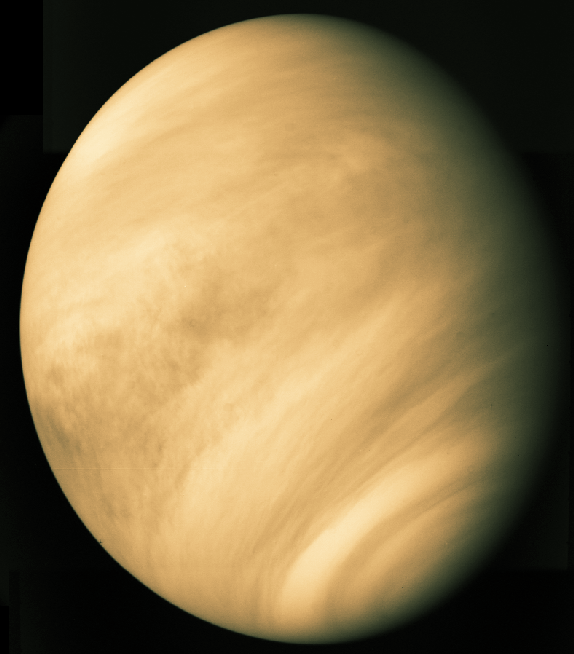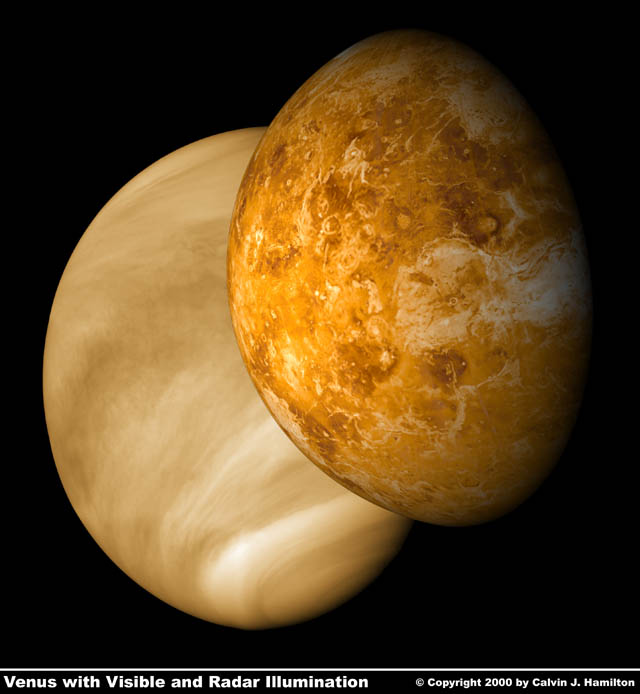
| VENUS
Venus is covered with a thick cloud layer that makes its surface
impossible
to see in visible light. As a result, it has been quite difficult
to form conclusions about the processes and forces which have shaped
Venus's surface. Because of Venus's similarity to the Earth, however, it
was expected that the processes which shaped Venus's surface would be
similar to the processes which shaped the Earth's surface.
The conditions on Venus's surface are, however,
different from those on the Earth and may be extreme enough to play
a role in the evolution and formation of Venus's surface features.
-
Venus's atmosphere of carbon dioxide is ~ 100 times more massive than
the atmosphere of the Earth and Venus has a Runaway Greenhouse
Effect that has
raised its surface temperature to
800-900 F. This is not hot enough to melt rocks, but can make
surface rocks softer and less dense than those on the Earth;
this may make the
lithosphere of Venus weaker than that of the Earth.
- The thick atmosphere destroys
and slows down incoming meteroids;
cratering by smaller objects is less than common than
found on the Earth. On Venus, there is a lack of craters with
diamter less than ~ 1.5 kilometers on Venus and the number of craters
with diameters less than 30 kilometers is deficient.
The cratering density on Venus suggests that
Venus's surface is young (like Earth's), less than a billion
years old and, in places, can be as young as
200-300 million years old.
- Venus's atmosphere has very little water.
On Earth, if we spread
the water around, it would cover the Earth to a depth of a few kilometers
(the oceans). On Venus, if you were to cover the planet with all of its
water it would cover the planet to a depth of a few centimeters.
Venus is extremely dry.
It is not clear what effect this has on
plate tectonics.
|
 |
Magellan
Beginning in 1990 and continuing until 1993, the Magellan
spacecraft
mapped the surface of Venus using
radar
ranging.
To get around the problem of the dense cloud layer,
Magellan viewed the
surface of Venus using microwave radiation. Microwave
radiation is a type of light
with longer wavelength
than visible light. Microwave radiation is able to
penetrate the cloud layer of Venus. |
 |
Magellan was in a polar orbit about Venus and let the planet turn
underneath it. As Venus turned under Magellan, Magellan shot a
radar beam toward the surface of Venus.
The craft then measured the amount of time it took
for the radiation to go to Venus and return to the craft. Knowing
that the radiation traveled at the speed of light, it was
easy to figure out far the ground was from the craft at any given time.
This allowed Magellan to map the changes in elevation (the ground) on Venus.
In this manner, Magellan mapped the surface of Venus with a
horizontal
resolution of 100 - 300 meters and a vertical resolution of 80 meters.
Magellan also measured how intense was the returning
radiation.
The reflectivity of the surface of Venus depends
upon the composition of the surface material and
how rough is the surface. |
 |
Venusian Topography and Volcanism

The surface of Venus has three types of terrain
(rotating Venus,
rotating topo map of Venus):
- Rolling plains
cover about 65 % of the surface of Venus, regions characterized
by numerous craters and circular basins, many of which are apparently
filled with lava and resemble lunar maria.
- highlands which cover about 8 % of the surface
concentrated in three major regions
, two of which Ishtar Terra
(in the northern latitudes) and
Aphrodite Terra (on the equator south and east of Ishtar
Terra)
are comparable in size to the continents of Africa and
Australia. The third, Beta Regio, is much smaller.
The maximum
elevation above the mean surface level, the summit of a mountain called
Maxwell Montes (located in Ishtar Terra),
is greater than that of Mt. Everest but smaller
than Olympus Mons. Maxwell Montes's summit is 11 km above sea level
(but only 6 km or so above the plain on which it resides)
with a base 853x700 km. Because of its size, it is the coolest region on
Venus (about 716 F) with the lowest pressure (60 bars). There are
adjacent parallel valleys and trenches in the highlands, some forming
systems up to 9,000 kilolmeters in length ( rifts? Probably not
according to Magellan which finds no sign of spreading).
- lowlands which cover the remaining 27 % of
the surface
It is clear that there are many volcanoes on Venus (indicating active geology
in the past). However, Magellan saw no definitive evidence of current
volcanism
(as had been hoped). However, other indirect evidence suggests that volcanism
may still be ongoing:
- Sulfur dioxide
is detected in Venus's atmosphere; the amount undergoes
large
fluctuations. Sulfur dioxide is put into the atmosphere via volcanism on the
Earth.
It is conceviable that the large observed
fluctuations in sulfur dioxide are
due
to current volcanism on Venus
- The Pioneer and Venera probes detected
bursts of radio
emission in the atmosphere of Venus similar to types seen from the
plumes
of Terrestrial volcanoes.
Unfortunately, Magellan did not see a volcano in the act of erupting, so the
issue is not settled. Magellan did see signs of recent volcanism, however,
e.g.:
Magellan also found widespread evidence of other types of geological activity;
deformations indicating large internal stresses, e.g.,

| CORONAE
Found only Venus, coronae are produced as extremely viscous magma upwells
causing the surface to bulge. Typically they have diameters on the order
of hundreds of kilometers with the largest one, Artemis Corona, having a
diameter of 2,600 kilometers. The coronae usually have volcanoes in and
near them. The cracks near the coronae form because magma flows into
pre-existing fracture patterns. When eruptions or other magma movements occur,
the magma drains from the fractures and the overlying surface rock collapses.
The smooth, flat region in the center of the corona is probably a relatively
young lava flow.
|

| ARACHNOIDS
Arachnods are
are circular to ovoid in shape with concentric rings surrounded by a network
of fractures extending outward. Arachnoids vary in diameter from 50 kilometers
to 230 kilometers. They are similar to, but generally smaller than coronae.
A theory suggests that arachnoids are precursors to coronae.
|

| FAULTING
Large faults are seen, but are not transform faults as found at
plate boundaries.
|

| CHASMASChasmas is a loose term describing
deep, elongated, steep-sided depressions.
To the right is the large chasma encircling Artemis Corona
located in Aphrodite Terra.
|

|
The conclusion for Venus is that there is ample evidence for
geological activity, but no compelling evidence for plate
tectonics.










